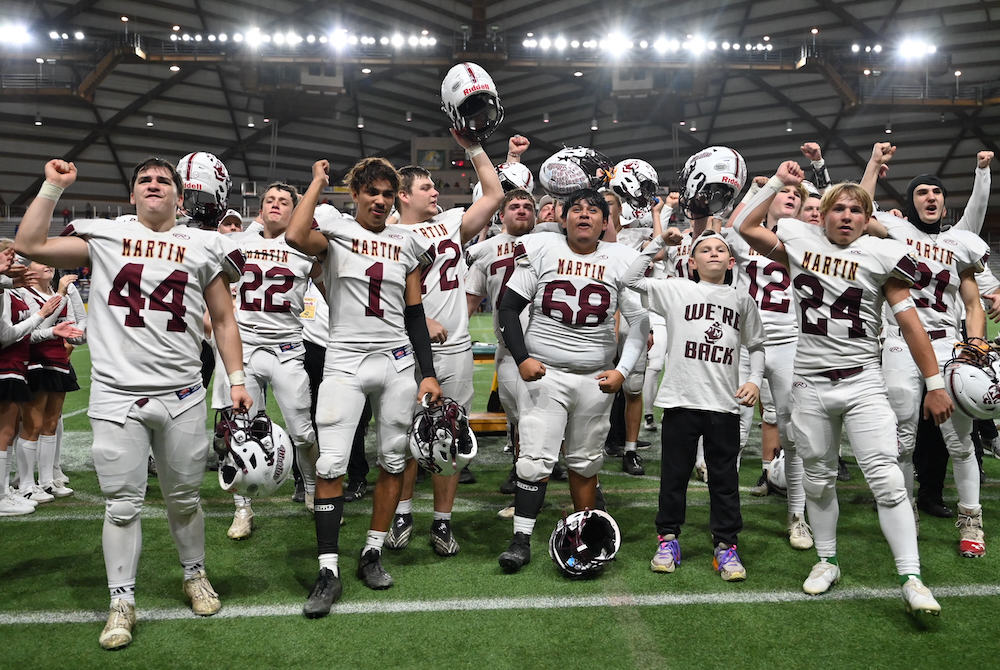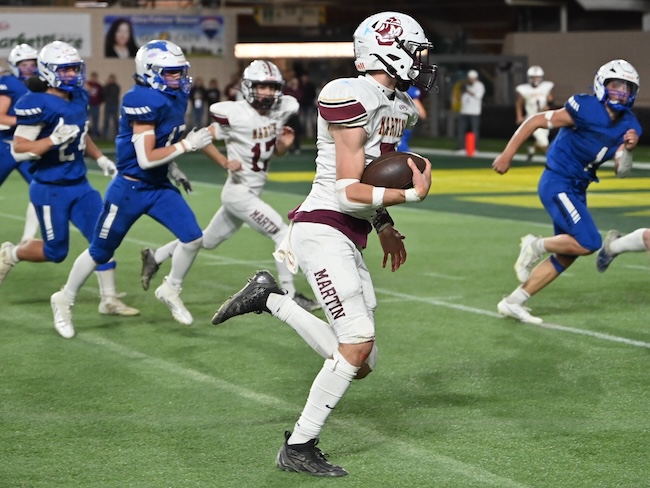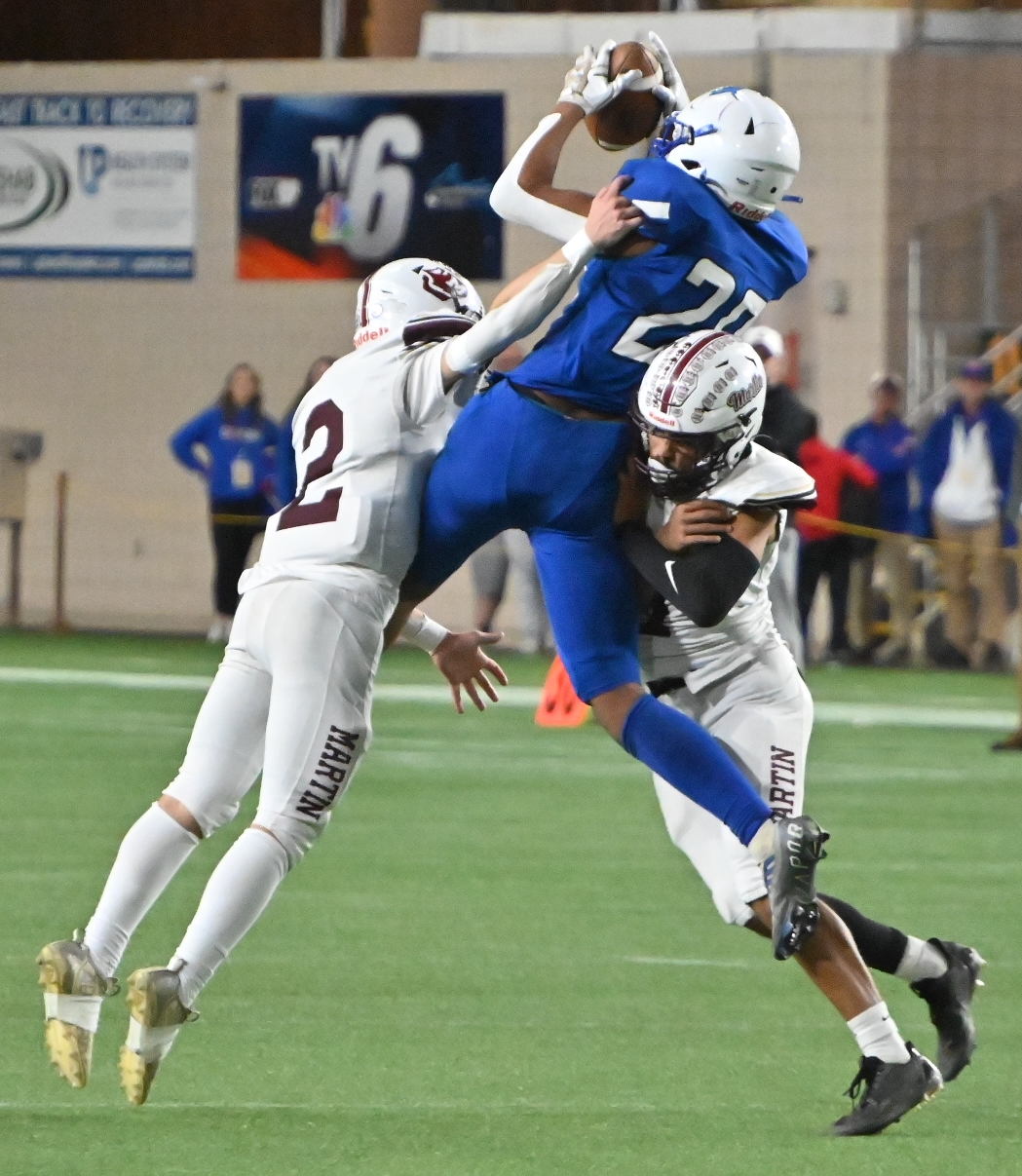
MHSA(Q&)A: NFL official Ronald J. Winter
July 19, 2012
By Brian Spencer
Second Half
 Kalamazoo's Ron Winter has officiated in the National Football League for nearly two decades, and became a referee in 1999. But long before he joined the highest level of the game, he got his start on Michigan's high school fields.
Kalamazoo's Ron Winter has officiated in the National Football League for nearly two decades, and became a referee in 1999. But long before he joined the highest level of the game, he got his start on Michigan's high school fields.
Winter has officiated that sport at all three levels and also high school and college basketball. He's also served as a source of knowledge for officials around the state -- and an example for those hoping to start at the high school level and climb to the pros.
Winter remains registered as an MHSAA official, as he's been for 42 years. An associate professor emeritus of human performance and health education at Western Michigan University, Winter was appointed earlier this month to serve a two-year term on the Governor's Council on Physical Fitness, Health and Sports. The council focuses on increasing physical activity and health improvements.
He served on the WMU faculty first beginning in 1969 and then again from 1992-2008. Winter earned bachelor and master's degrees at Michigan State University.
Did you play any sports in high school or college?
I played football, basketball, baseball, and track in high school. However, once I got to Michigan State University, I started playing lacrosse. A couple guys that lived near me played lacrosse and asked me to come out to throw the ball around. After throwing with them a couple times they asked me to come out for the team. I ended up playing lacrosse for MSU for four years.
How did you decide to choose football as the sport you would officiate?
I started officiating as a student at MSU in their intramural program, officiating touch football and basketball. The next logical step was to then officiate in the high school leagues. From there, I began to proceed to all the different levels.
Are there specific requirements for becoming an NFL official?
The biggest requirement is experience. The progression that I went through went like this:
After officiating high school games, I went to the MIAA (Michigan Intercollegiate Athletic Association). They (MIAA) were looking for people that had 3-5 years of experience at the high school level. From there I went to the Mid-Continent conference. I wasn’t able to go to the Mid-American Conference because I was employed at Western Michigan University.
From there I went to the Big Ten. The Big Ten was looking for people with 5 to 10 years of experience in high school and people that had experience at different positions as an official. I ended up officiating in as a Big Ten football official for 10 years and a Big Ten basketball official for 15 years. I then submitted an application to the National Football League. Coincidentally, the NFL was scouting officials, and had followed me for four years before they finally asked me to be a part of the staff. The NFL decides on who they want to pursue through recommendations and personal interest. They look for personality traits as well as how (officials) carry themselves through different situations.
What has been your favorite level to officiate; High school, college or professional?
I enjoyed officiating all of them, but for different reasons.
I found high school to be the most fascinating because it’s all about the kids; they are playing the game for the love of the game. That is the purest sense of the sport. I loved being involved with kids simply because they love the game.
I found the Big Ten to be most exciting because of the kind of atmosphere that exists on a Big Ten campus on a Saturday afternoon. It’s electric. You don’t get that same sense or the same feel on Sunday afternoon in a pro stadium.
I found the NFL to be most intense. The NFL really has three or four different levels of play during the season. There is preseason play, the first thirdof the season, the second third of the season, and the last five games of the season. Each level is ramped up another notch as the season progresses. Playoffs are entirely different all together. In terms of the intensity and pure speed of the game, there is nothing like the NFL playoffs.
How important is getting along with your fellow officials on the field?
It’s imperatively important if you want to have a smooth and well-run game. This doesn’t mean that you have to buddy-buddy off the field, but on the field you have to be committed to one goal. We spend two or three hours on meetings Saturday afternoon to go over rules tests, tape, and more to prepare for the next game (and) to get over rough patches that develop on a personal level in a previous week. I need to know that the other six guys are focused and thinking about football like me. Everyone has to have confidence in one another. We spend plenty of time on Saturday to get to the point that we need to on Sunday.
What has been the most exciting game you’ve officiated?
I’ve been in plenty of exciting games from NFL playoff games, to the first Orange Bowl game, to the Rose Bowl, to the Division III Hope vs. Calvin basketball game, to when Indiana played Purdue in basketball. All of them were incredible to be a part of. During the Indiana vs. Purdue game, the arena was electric. The players, coaches, fans were intense. Everybody is totally focused on the game. Each coach had a tremendous respect for one another. Neither one wanted to show up or embarrass their counterpart. This game wasn’t that drastically different at the Division III level, however. The intensity of both was very similar.
Are there games that you get excited to officiate more than others, presently?
Not in terms of specific teams. It really just depends on the circumstances, of course. Pittsburgh vs. Baltimore is an intense game. The Jets vs. Patriots game is great. There are clearly rivalries that are very exciting to be a part of. The level of play and intensity of the athletes in the NFL is unmatched and can provide excitement every week.
What is the most difficult aspect of being a NFL official?
I would say that preparation and being able to maintain intensity on the field on Sunday are key aspects. The preparation is difficult because it’s time-consuming. It is a misconception that we simply show up on Sunday to work the game. By the time Sunday rolls around, I’ve spent over 20 hours during the week trying to prepare for a Sunday game. It isn’t hard in terms of physical labor, but difficult in terms of a time commitment. You have to have an understanding family to be in the occupational field that I am in.
Do you have any advice for aspiring officials who hope to make it to the league?
Practice, practice, practice. Be able to work any game at any level and get as much experience as you can. Be a good partner on the field. It takes time; it isn’t something that just happens. Like anything else, it takes practicing your trade to be able to make it to the top level.

Martin Caps Frantic Final Minutes with Unforgettable Comeback at Superior Dome
By
Jason Juno
Special for MHSAA.com
November 18, 2023
MARQUETTE --- Martin had it easy last year, at least from a stress and anxiety standpoint.
Sure, the 8-Player Division 1 Final was competitive in the first half, but Martin went on to win the championship game by 50 points, hardly anything to sweat too much about.
But this year?
Oh goodness.
Martin took possession of the ball on its own 15-yard-line with 1:15 on the clock and trailing by two scores, 26-14, to an Indian River Inland Lakes team determined to win its first Finals title on the football field.
And Martin won. A state title game for the ages, the Clippers claimed it 30-26 to repeat as champions despite also trailing 20-0 to start the fourth quarter.
It was still a 20-point margin, 26-6, when the Bulldogs scored what seemed to be the insurance points they needed with 6:26 left.
“It’s amazing,” Martin coach Brad Blauvelt said. “I’m not gonna lie – doubt creeps into your head when it’s 20-6, they’re driving down the field, they’re running the clock. … We made plays, we made plays when it counted the most.”
Inland Lakes built its big lead with a stout red zone defense – Martin got there on every one of its possessions but didn’t cash in until the final quarter – and a four-touchdown day from junior quarterback Aidan Fenstermaker.
It was the first Finals appearance for Inland Lakes, which had its two winningest seasons over the last three years. Coach Travis Meyer’s message to the team after such a heartbreaking loss was about focusing on getting here – no easy feat itself – and about the upperclassmen guiding the rest of the team so that their run of success isn’t complete.
 “No one in the state, based on any rankings, based on any newspaper articles, based on anything really, expected us to do what we did,” Meyer said. “And then even the ones that weren’t totally shocked that we were here didn’t think it was going to be a four-point game. Regardless of when the points were scored, that’s still a four-point game, that’s a hell of a state championship. That could have gone lots of different ways, and I don’t think anybody really expected us to give them a shot.”
“No one in the state, based on any rankings, based on any newspaper articles, based on anything really, expected us to do what we did,” Meyer said. “And then even the ones that weren’t totally shocked that we were here didn’t think it was going to be a four-point game. Regardless of when the points were scored, that’s still a four-point game, that’s a hell of a state championship. That could have gone lots of different ways, and I don’t think anybody really expected us to give them a shot.”
They certainly did that. Martin, though, had an epic response.
The Clippers scored quickly, going 70 yards in a minute and a half, with Haylen Buell’s one-yard touchdown run pulling the Clippers within 26-14 with 4:54 left.
The Bulldogs recovered the Martin onside kick attempt and marched right into the red zone on the ensuing drive. But they turned it over on downs with 1:33 left.
That meant Martin had to go 85 yards just to pull within one possession with the clock even more daunting than the distance.
It took them a minute. The Clippers capped the drive as Taegan Harris caught a 10-yard scoring pass from Gavin Meyers with 33 seconds to go. The conversion pass made it 26-22.
Everything came down to the onside kick by sophomore Ben Romero. The bouncing ball went off at least two Inland Lakes players before Martin’s Mike Branch recovered it.
Martin had tried an onside kick after its previous two scores as well, but this was the only one that worked.
“They timed it perfect,” Meyer said. “That kid has a heck of an onside kick, it gets there at the same time as his kids. Whether you’re ready for it, whether you’ve got your best athletes there or not, that’s hard to do, especially on a stage like this, in that moment. That is hard on anybody, even the pros.”
The Clippers took over at their 45 with 32 ticks on the clock. Before long they were at the 21.
Meyers looked to pass, scrambled and then ran 21 yards for the touchdown with five seconds remaining.
“It was a pass play, trying to get it to Abe (Dykstra),” Meyers said. “The middle opened up, and I just took off.”
He said he was just hoping to get out of bounds, with the clock running down, but he was able to get in the end zone.
“We thought we could keep them out for two more plays,” Meyer, the Bulldogs’ coach, said. “We lost contain somewhere there around the edge.”
 The unfathomable score: 30-26 after the conversion.
The unfathomable score: 30-26 after the conversion.
Martin lost a lot of seniors from last year, including three all-staters. The Clippers didn’t win their conference, and they fell to 2-2 early in the year with losses to Bridgman and Gobles. They haven’t lost since, though, winning nine straight games with a young team.
“It’s nice to be able to leave a legacy,” said Harris, a senior. “Last year, we had a pretty stacked group of guys. We had three of our star players injured this season, it wasn’t looking good, 2-2, then we won, what, nine, eight straight? … It feels really good.”
Meyers, who threw for 216 yards and ran for 142 on Saturday, filled in for one of those all-state graduates quite well, J.R. Hildebrand.
“He’s a damn good football player,” Blauvelt said of Meyers. “And he’s grown a bunch. Halfway through the year, he started moving in the pocket, keeping his eyes downfield. You saw it today, right, he kept his eyes downfield.”
After a scoreless first quarter, Inland Lakes scored twice during the second quarter. The Bulldogs took over for the final drive of the half at their own 12 with 3:05 remaining. They went for it on 4th-and-6 at their own 31 and again on 4th-and-6 at the 47. They converted both and were rewarded with a touchdown as time expired. Despite being pressured, Fenstermaker hit Jacob Willey in the corner of the end zone for a 24-yard touchdown pass that put Inland Lakes up 14-0 at the half.
Meyer said his team punted once this year and once last year.
“We don’t put a ton of time into punting,” he said. “So when the best we can do is maybe get off a 25-yard punt and they return it 10 yards before we cover it, we figured that was only 15 yards of field position anyway, so we might as well give ourselves a shot. It was playing the odds. Maybe people don’t like that logic, but we like to play aggressively. We like to see what we can do.”
They built the lead to 20-0 late in the third quarter as Martin came up empty on all four of its drives, even though every one of them got into the red zone.
“It was very frustrating,” Blauvelt said. “We saw on film, they stopped Pickford (in the Semifinal) inside the red zone multiple times, they tightened up when they got in there. We shot ourselves in the foot in the first half. But we moved the ball consistently, but yeah, that was a little frustrating. We had some good drives, and we just couldn’t punch them in.”
It just wasn’t as frustrating as the finish was for the Bulldogs.
Inland Lakes senior Payton Teuthorn said getting to this point was what they wanted since youth football.
“We made it here. We just couldn’t finish,” he said.
PHOTOS (Top) Martin players celebrate with their fans Saturday the program’s second-straight 8-Player Division 1 championship at Superior Dome. (Middle) Martin quarterback Gavin Meyers charges toward the end zone on the way to scoring the game-winning touchdown. (Below) Inland Lakes’ Andre Bradford (20) pulls in a catch as two Martin defenders converge including Bryer Watson (2). (Click for more photos by Cara Kamps.)

